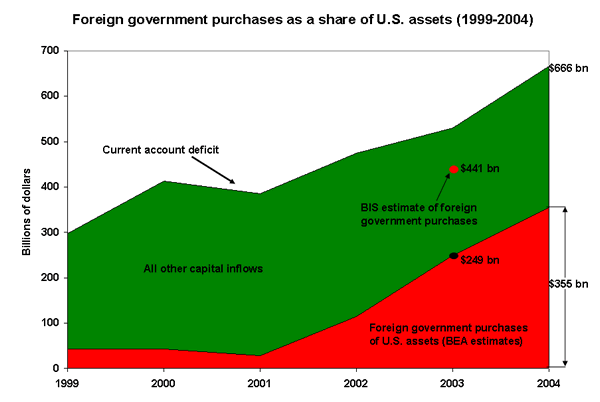See Snapshots Archive.
Snapshot for December 16, 2004 (revised March 16, 2005).
Current account deficit likely to worsen before it improves
The Bureau of Economic Analysis (BEA) announced today that the current account (the broadest measure of the U.S. deficit in the trade of goods, services, and payments to the rest of the world) reached an all-time annual high of $666 billion in 2004, a 25.5% increase and $135 billion more than in 2003. A major factor contributing to the rising trade deficit is the effort by foreign governments (especially those in Asia) to boost the value of the U.S. dollar by purchasing large amounts of U.S. assets such as treasury bills and other government securities. Unfortunately, the deficit is still likely to get worse in the near term.
A trade deficit must be financed by net borrowing from the rest of the world. The United States was effectively spending about 5.7% more (about $2 billion every day) than it was producing in 2004, but it cannot continue to borrow at such high levels forever. Worse yet, the trade deficit is growing each year as a share of gross domestic product (GDP). The decline in the value of the dollar since February 2002 primarily the 35.4% decline against the Euro has failed to stem the increase in the current account deficit, which has increased by 0.9 percentage points as a share of real GDP since 2003.
If the dollar were being supported by demand from investors who find the U.S. market attractive, then steady growth in capital inflows from private investors to finance rising deficits would likely occur. However, private inflows have fallen in the last three years. Instead, foreign governments have been intervening in foreign exchange markets by purchasing a rapidly growing volume of U.S. government assets (shown as foreign government purchases of U.S. assets in the figure below). The BEA reported today that these inflows were $355 billion in 2004, or 53.3% of the funds necessary to finance the U.S. deficit. The BEA also reported that foreign governments financed 46.8% of the U.S. current account deficit in 2003.

However, recent research by the Bank for International Settlements (BIS), a global clearing house for the world’s central banks, revealed that the United States is even more dependent on loans from foreign governments than the BEA data had indicated. The latest BIS survey showed that foreign authorities net purchases equaled $441 billion in U.S. assets in 2003, 77% more than the $249 billion reported by the BEA. In fact, the BIS shows that net official inflows financed 83% of the U.S. current account deficit in 2003, and not 47%, as reported by the BEA.1 If that differential continued in 2004, then foreign governments essentially financed the entire U.S. current account deficit in 2004.2
A bloc of Asian governments made 78.9% of all government purchases of U.S. assets in 2004.Asian governments, especially Japan and China, are willing to absorb the risks of financial losses from an ultimate decline in the dollar in order to make their exports more competitive against U.S. production in this country and around the world. If these governments had not been intervening in foreign exchange markets, then the dollar would have fallen much more than it has since 2002. In fact, the real value of the dollar has only fallen 4.2% in the past year. The dollar would have declined much more rapidly, especially against Asian currencies, without the intervention of foreign governments in currency markets. Imports of goods and services were 54% larger than exports in 2004. Due to this large imbalance, the current account will continue to decline. The dollar will have to fall much further than it has to date just to stabilize the current account deficit. In fact, exports would have to grow 54% faster than imports just to keep the trade deficit from expanding.
For more information about the current account deficit, see the December 2004 Issue Brief Debt and the Dollar, by EPI economist L. Josh Bivens.
Notes
1. Higgins, Mathey and Thomas Klitgaard. 2004. “Reserve Accumulation: Implications for Global Capital Flows and Financial Markets,” Current Issues in Economics and Finance. 10(10), September/October. http://www.newyorkfed.org/research/current_issues.
2. The BIS data on official inflows for 2004 will be released in the BIS. 2005. Annual Report. Detailed Statistics from the 2004 report estimate that Asian governments 85.5% of the U.S. current account deficit in 2003, slightly lower than reported in the BEA statistics.
This Snapshot was written by EPI economist Robert Scott, with research assistance from David Ratner.
